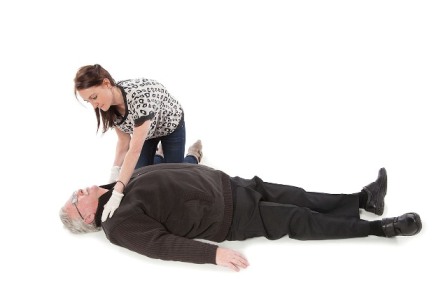How to treat a sudden cardiac arrest (SCA)
Date: Thursday, 03 March 2016. -
Blog, First Aid, Defibrillators
A sudden cardiac arrest (SCA) often occurs without any warning when the electrical activity of a heart becomes so chaotic that it stops pumping blood around the body. In the UK, there are 30,000 cardiac arrests each year out of hospital, and only one in 10 victims survive to be discharged.
When someone suffers an SCA, every minute that goes by without them receiving help decreases their chance of survival by 10%. Even an untrained person can take action to help someone suffering from an SCA, help which could potentially be life saving.
If you suspect someone has suffered an SCA, you must remain calm but act quickly. Follow the steps below if you find yourself faced with this kind of emergency.
Step 1 - call 999 immediately
Even if you are uncertain whether you are dealing with a sudden cardiac arrest, you must make sure either yourself or someone near you has called an ambulance.
If you have not had CPR training and are unsure what to do next, the phone operator will be able to talk you through the process. They will also be able to advise you if there is a public access defibrillator nearby.
Step 2 - identify a SAC
If the victim has lost consciousness, you can identify if they have suffered an SCA by:
- Checking for a response- speak to the person and tap their shoulders hard. See if you can get some kind of response out of them
- Checking for a pulse- if someone has had an SCA they will have no pulse. Check the person’s pulse via their wrist or neck
- See if the person is breathing - Check to see if you can feel or see the person’s chest rising up and down or listen for their breathing near their mouth and nose.
If a person is unresponsive, not breathing and has no pulse, they will be suffering from an SCA. Remember, time is of the essence here so make sure you complete these checks as quickly as possible.

Step 3 - begin CPR
When a person has an SCA, you must perform CPR immediately. CPR means pressing down hard on a person’s heart to pump blood and keep circulation going around their body until help arrives, and supporting breathing by inflating a person’s lungs via mouth to mouth resuscitation.
If you have not had any CPR training before, you can still administer it to an SCA victim.
- Place your heel of your hand on the victim's breastbone with your other hand on top and interlock your fingers
- Move so your shoulders are above your hands
- Press straight down on a victim's chest, about a third of the way, hard and fast 30 times in a regular rhythm (singing or counting to keep track can often help with this)
- If you feel comfortable doing so, perform mouth to mouth with 2 breaths for every 30 chest compressions
- DO NOT BE AFRAID OF HURTING THE VICTIM. You cannot possibly cause them any more damage by administering CPR and are helping to increase their chances of survival. A person who has suffered an SCA is considered clinically dead, so never worry about causing a person any more harm
Step 4 - administer a shock via a defibrillator
When a person has a sudden cardiac arrest, their heart rhythm can sometimes be corrected via an electric shock through the chest wall with a device called a defibrillator.
Defibrillators are completely safe for members of the public to use and are often available in public places. The machine will talk you through the steps you must take to administer the shock and will never shock a person whose heart does not need it.
The emergency services phone operator should be able to advise you if there is a public access defibrillator nearby, and you can ask staff members if you are in a public place. Shopping centres, gyms, train stations and village halls should all have access to a defibrillator.
Step 5 - continue administering CPR and using the defibrillator until help arrives
To help increase a person’s chance of survival you must continue to administer CPR and follow the instructions from the defibrillator until help arrives. Then, the ambulance staff will take over.
Dealing with someone who is having an SCA can be an unfamiliar and unsettling experience, but your quick thinking and actions could be potentially life-saving to the person suffering from the cardiac arrest. Remain calm, act quickly and you will give the victim their best chance of survival.
